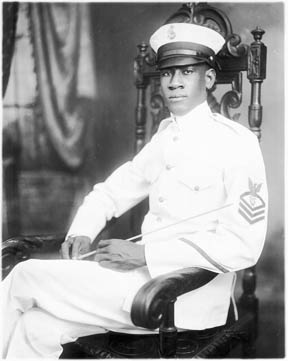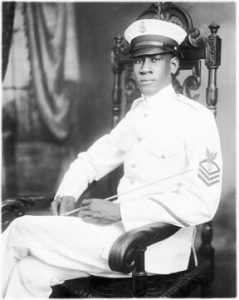Alton Augustus Adams, Sr. (November 4, 1889 – November 23, 1987) is remembered primarily as the first black bandmaster in the United States Navy (beginning 1917). His music was performed by the bands of John Philip Sousa and Edwin Franko Goldman and his march “The Governor’s Own” (1921) appears as the first selection on the bicentennial album Pride of America, released by New World Records.
The St. Thomas-born son of aspiring artisan parents, Adams attended elementary school and later apprenticed to become a carpenter and then a shoemaker. During this time, he nurtured a passion for music and literature. Adams learned to play piccolo (chosen primarily because the instrument was less expensive than a full-size flute) and joined the St. Thomas Municipal Band in 1906. Simultaneously, he studied music theory and composition late into the nights through correspondence courses with Dr. Hugh A. Clark at the University of Pennsylvania. In June 1910, Adams broke away from the Municipal Band to form his own ensemble—the Adams Juvenile Band. Adams’ band developed rapidly, becoming part of the social fabric in the islands’ capital city—the port of Charlotte Amalie—by playing for a variety of social and charitable events as well as regular concerts in the city’s bandstand at Emancipation Garden, a location that remembers and celebrates Governor von Scholten proclamation which gave freedom to the slaves in 1848.
Adams had come to depend on music magazines from the U.S. mainland as a source of ideas and learning about music. His passion for reading and writing bore fruit as early as 1910 when he first contributed an article on the black composer Samuel Coleridge Taylor to The Dominant. In 1915, he became the music editor for the St. Croix newspaper The Herald. A year later he became the band columnist for Boston’s Jacobs’ Band Monthly. Bands at the time mostly performed rearrangements of orchestral music and Adams highlighted original works. Adams’ essays garnered the attention of leading musicians in the States, such as John Philip Sousa and Edwin Franko Goldman. His grandiloquent prose style amplified a philosophy of social idealism about music’s educational role in the community. When on the eve of its entrance into World War I, the United States purchased the Virgin Islands from Denmark, Adams possessed a unique combination of administrative skill and community service with credibility on the U.S. mainland and no problematic political entanglements that allowed him to take advantage of an unprecedented opportunity.
On June 2, 1917, Adams and his entire Juvenile Band were inducted into the United States Navy, thus becoming the first African-Americans to receive official musical appointments in the U.S. Navy since at least the War of 1812 and making Adams the Navy’s first black bandmaster. It was an exceptional situation inspired by exceptional circumstance: the need to build a bridge between an all-white naval administration and a predominantly black population. Adams used his authority as bandleader and Chief Petty Officer with the Navy as a source of power, wealth, and influence. Their induction not only helped to defuse the racial tension that plagued the Navy’s presence on the island during World War I, but the band, and Adams in particular, functioned as educators to naval administrators about the needs and attitudes of Virgin Islanders. Further, Adams continued to grow into his role as a social leader on the islands, serving as an officer of the local chapter of the Red Cross, helping to found the public library in Charlotte Amalie, and developing the islands’ public school music education program.
He traveled to the U.S. mainland for the first time in 1922 to research music education programs, but the highpoint of his naval career was a 1924 tour of the U.S. eastern seaboard. With his U.S. Navy Band of the Virgin Islands in top form, Adams and the band won accolades from concert and radio audiences in Hampton Roads Virginia, Washington, D.C., Philadelphia, New York, and Boston. Adams’ music is in the style of John Philip Sousa and communicates energy along with a core patriotism. His best known works include the “Virgin Islands March” (1919), “The Governor’s Own” (1921), and “The Spirit of the U.S.N.” (1924), dedicated to President Calvin Coolidge. This trip would turn out to be the apex of the band’s success; the band never again enjoyed the notoriety on the U.S. mainland that its parades in Harlem had generated.
> > > > > > > >
Now comes the part where the U.S. turned their backs on the All Black Band:
> > > > > > > > >
Once all-but-forgotten, today Adams’ story and his music are undergoing a renaissance. The United States Navy Band has rediscovered his music and a book including Adams’ memoirs was published in 2007.
“The Governor’s Own” is available on The Golden Age of the American March (New World Records 80266) performed by the Goldman Band (Richard Franko Goldman conducting).
Go here to listen to a recording of “The Governor’s Own”, and to read the whole story:
https://en.wikipedia.org/wiki/Alton_Adams


